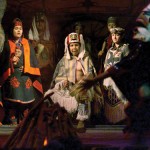
Lynn Armitage, Indian Country Today Media Network
When you think of Seattle, the first things that come to mind are probably the Space Needle, Puget Sound, the birthplace of Jimi Hendrix or maybe professional sports franchises like the Mariners or the Seahawks. Somehow forgotten among all the contemporary lore of this beautiful seaport is the knowledge that it teemed with Native Americans for at least 4,000 years before white settlers arrived.
In fact, Seattle, the largest city in the Pacific Northwest, is named after a leader of the Suquamish and Duwamish tribes, Chief Si’ahl. Other tribes in the area include the Muckleshoot and Snoqualmie. Today, many of them continue their long-held artistic traditions, including basket-weaving.
If you’re planning a trip to this vibrant city, you should by all means take in its traditional tourist attractions. But to really rock your visit with some Native American culture, we recommend these five destinations, all off the beaten path:
Daybreak Star Indian Cultural Center
Located on 20 acres in Discovery Park, Seattle’s largest city park, with views of Puget Sound and the Olympic Mountains, the Daybreak Star Indian Cultural Center is a central hub showcasing all the Native tribes in the area. Daybreak Star serves many purposes, says its parent organization, the United Indians of All Tribes Foundation—a conference center, a pow wow venue, a gathering place for after-school programs and an art gallery that features a large body of work by Native artists.
For more details, go to UnitedIndians.com/daybreak.html.
Tillicum Village Adventure
For a real taste of Native culture—literally—go on a four-hour escape to Tillicum Village on Blake Island, just eight miles west of Seattle, in Puget Sound. Guests are treated to steamed clams upon arrival and can watch a traditional Northwest Coast salmon bake in the longhouse. After the feast, enjoy a Native music and dance show that tells the colorful story of the Coast Salish Tribes, also called the Puget Salish or Lushootseed peoples. Daily tours run from May through September.
For ticket prices and tour details, go to TillicumVillage.com.
Juanita Bay Park
If you’re up for a beautiful drive to observe the region’s abundant wildlife, Juanita Bay Park is a quick 15 miles east of Seattle, on the other side of adjoining Lake Washington. It’s a 110-acre marshy wetland that is home to all kinds of wildlife, including songbirds, shorebirds, turtles and beavers. Guided tours are available, or walk along the paved trails and boardwalks solo. Either way, you will learn a lot about this natural habitat through interpretive signs that are positioned throughout the park. Don’t forget to bring your binoculars!

For more details, go to KirklandWa.gov.
Burke Museum of Natural History and Culture
Located at the University of Washington, the Burke is the state’s oldest museum. It is dedicated to honoring, researching and sharing the heritage of diverse peoples from all over the world, including the many Native tribes in the state and beyond. Here you will find thousands of Coast Salish artifacts and artworks, as well as a number of exhibits that feature artwork from other tribes, such as the Tlingit and Haida of British Columbia and southeast Alaska.
For more details, go to BurkeMuseum.org. (On this site, you will also find an extensive list of Native American cultural centers and museums. Just type “Native Americans” into the search box.)
The Center for Wooden Boats
A must-see for aquatic enthusiasts is the Center for Wooden Boats, a fun place for the family to learn about boats—on and off the water. The center refers to itself as a “living museum,” since visitors can take their historic wooden boats out for a quick sail. Free public boat rides are offered on Sundays. Tourists can also learn how to carve northern-style canoes from a Haida carver named Saaduuts, the artist in residence, who holds classes periodically just across the way in Lake Union Park as part of the Canoe Project, a partnership of the center, United Indians of All Tribes Foundation and Antioch University Seattle.

Read more at http://indiancountrytodaymedianetwork.com/2013/02/24/going-native-inseattle-147854
